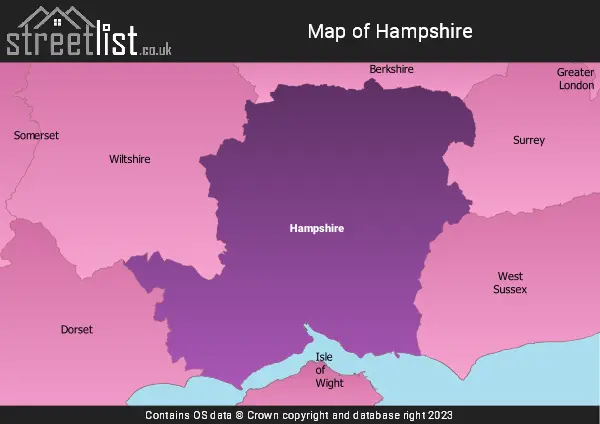The Ceremonial County of Hampshire is situated in South East England.

The area of Hampshire is 1,488 Square Miles (3,854 Square Kilometres). Making Hampshire the 18th largest county in Great Britain (out of 91) and the 10th largest county in England (out of 48).
Discovering Hampshire: A Blend of History and Modernity in the UK
Nestled in the south of England, Hampshire is not just another county. It's a diverse mix of modernity and antiquity, presenting a captivating blend of sleepy villages, high-tech industries, bustling town centres, and expansive green landscapes.
The Origin of a Name
Contrary to what many believe, Hampshire doesn't derive its name from a county town, as is typical with many other counties. Instead, its name springs from the port of Southampton. Over time, "South" was omitted, leading to its contemporary moniker. Up until recent history, it was also referred to as the County of Southampton, a title that persisted even within the County Council's designation until the 1970s.
The Administrative Heart: Winchester
Although the name 'Hampshire' stems from Southampton, the official county town is Winchester. This historic location houses the Hampshire County Council, set within the majestic surroundings of the Castle.
Natural Wonders and Historic Sites
Travelling through Hampshire is akin to a journey through time. The southwest houses the renowned New Forest, an ancient royal hunting ground christened "Nova Foresta" by William the Conqueror. Venture eastward along the coast, and you're greeted by the Solent, a natural harbour separating the mainland from the Isle of Wight. Anchored in the Solent's midst is the Hamble River, a longstanding hub for trade and shipbuilding.
Southampton, situated along this coastal stretch, is a town rich in maritime history. It waved farewell to numerous voyagers, including those aboard the ill-fated Titanic and the revered Mayflower and Speedwell vessels, which transported the Pilgrim Fathers to America's shores.
Further east lies the naval stronghold of Portsmouth. Here, maritime enthusiasts can marvel at Admiral Nelson's flagship, the HMS Victory.
Central Hampshire offers more treasures. Winchester, once England's capital, is a former Roman city boasting the awe-inspiring Winchester Cathedral.
Towns of Significance
In the northwest, Andover beckons with its Museum of the Iron Age, while northeast introduces Aldershot, the British Army's cradle, and Farnborough, widely recognized as the birthplace of aviation. This was the original site of the British Army Balloon School, where Samuel Cody, the brother of famed Wild West showman Bill 'Buffalo Bill' Cody, made groundbreaking contributions.
Samuel Cody, distinctively recognized by his extravagant long hair and facial hair, was a pioneer in the realm of manned kites. These kites would frequently soar over Farnborough, often with a passenger aboard. In the absence of willing test pilots, Samuel's audacious wife, Maud, would often step in to fill the role. These manned kites laid the groundwork for the evolution into early flying machines, leading many first-generation aviators to affectionately refer to their aircraft as 'kites'. However, Samuel's pioneering journey met a tragic end when he was killed in an aircraft crash over Farnborough.
Between Farnborough and Andover lies Basingstoke, a lively town pulsating with activity.
Travelling Through Hampshire
Navigating Hampshire is made easy with the M3 motorway, bridging London to Southampton via Winchester. The A303, branching from the M3 near Basingstoke, is the primary route to the South West, aptly nicknamed the 'Highway to the Sun'.
With its compelling history, modern amenities, and a plethora of sights to explore, Hampshire truly does have something for everyone. Whether you're a history buff, nature lover, or simply seeking an escape from the city's hustle and bustle, this county promises an unforgettable experience.

A map showing the geology of Hampshire.
| Map Key | Description |
|---|---|
| 28 | SAND, SILT AND CLAY |
| 30 | CHALK |
| 46 | CLAY, SILT AND SAND |
| 48 | MUDSTONE, SANDSTONE AND LIMESTONE |
| 57 | SANDSTONE AND MUDSTONE |
| 79 | CLAY, SILT, SAND AND GRAVEL |

A map showing the boundary of Hampshire in relation to other counties.
Map of the County of Hampshire
| Zoom Level | Latitude | Longitude |
| 6 | 53.521968 | -2.164306 |